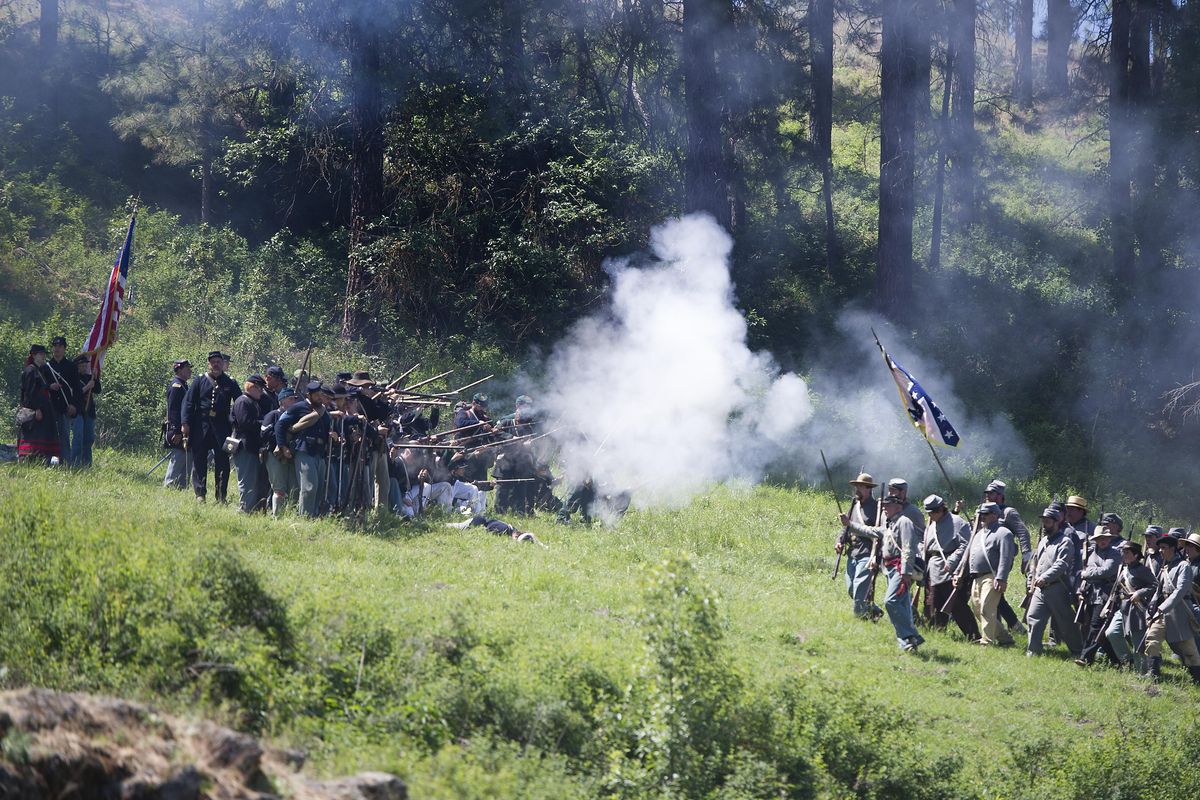Hundreds gather for Civil War battle in Eastern Washington

The Battle of Deep Creek got off to a slow start as Confederate and Union troops marched solemnly onto the field. But before long, young men were dying on the hill as the air filled with the sulfur smell of gunpowder.
The annual Civil War re-enactment staged its third and final battle on Memorial Day to a crowd of several hundred spectators. This year’s battle was based on the First Battle of Bull Run, also called Manassas by the Confederacy, which was the first major battle of the Civil War. Before the battle’s bloodshed, many people believed the war would be over in a matter of weeks.
“The Confederates showed us a thing or two,” said Darna Michie, a longtime re-enactor from Stevens County who helped organize this year’s battle. Her husband, Gary, leads the First Michigan Artillery unit.
The first round of cannon fire drew oohs from many of the spectators assembled on the side of the hill, who craned to get a closer look at the wobbling ring of white smoke floating up into the sky.
“It was pretty neat,” said Jonathan Steeber, an eighth-grader at Sacajawea Middle School. He was at the battle as part of the school’s unit on the Civil War, which requires students to complete a series of miniature projects, including attending a live event or watching a movie showing battles in progress.
Steeber said he liked the immediacy of the action in a live event.
“You get to watch the cannons fire off,” he said.
Following the battle, the soldiers gathered on the field with flags for the United States Army, Navy, Air Force, Coast Guard and Marines, and invited veterans to come out on the field with them. Law enforcement officers, firefighters and first responders also were invited onto the field as Confederate Army chaplain Danny Dougall delivered a prayer.
“We thank you for each and every person that has given their lives in sacrifice to this nation,” he said.
Air Force Maj. Brian Sikkema, who’s stationed at Fairchild Air Force Base, came to watch the battle with his family. He’s been serving for 10 years but was just assigned to Fairchild last year.
“We’ve never been to anything like this before,” he said of the battle.
Many of the re-enactors are also veterans, and about a quarter stepped forward during the ceremony. One was Rich Bright, a Yakima man who plays the Union cavalry commander. In his real life, he’s served three tours in Iraq, where he laments that he’s not allowed to bring his horse, Shawne.
His Civil War character is from West Virginia and didn’t identify with slaveholders from the richer part of Virginia, he explains.
“We didn’t have a lot of slaves. We didn’t have a lot of anything,” he said of his character.
President Abraham Lincoln, in the form of re-enactor Keith Deaton, also made an appearance. Deaton has a degree in U.S. history and has been playing Lincoln for 25 years, including last year at the Battle of Deep Creek. His brief speech focused on the need for a united nation, and included a reading from Lincoln’s second inaugural address, delivered in 1865.
“We were and we are and we will always be Americans,” Deaton said.
The Deep Creek battle is one of several put on annually by the Washington Civil War Association, which aims to educate people about history through live demonstrations. Inspired by a recent trip to Gettysburg, Pennsylvania, Michie included more historical presentations at this year’s battle, as well as a nighttime lantern tour showing off the army camps and a series of vignettes from the war.
Re-enactors come from all over the state and may only see each other a few times a year. After the day’s battle, they sit under canvas tents, drink lemonade and swap tidbits about authentic uniform design and Civil War history.
Many choose a side to portray based on their family history, though some units have Union and Confederate uniforms and can switch if a battle needs more people on one side or the other.
“This is just an extended family,” said Rhett Kearns, an Eastern Washington University history major who’s been a re-enactor for several years.